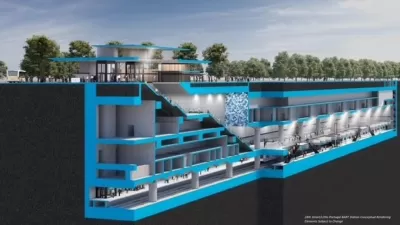A long-awaited extension of the Bay Area’s regional rail transit system is finally coming into view, with an expected completion date of 2030.
Bay Area Rapid Transit (BART) and Santa Clara Valley Transportation Authority (VTA) officials recently announced log-awaited plans to commence construction on Phase II of the BART extension into the Silicon Vallley.
Phase II has already been in the works for years, first making the Planetizen newsfeed in 2016, and Phase I wrapped up in 2020, when service started rolling into Milpitas and San Jose. Phase II will build a six-mile route serving three underground stations, “one at 28th Street in San Jose's Little Portugal, another near the intersection of Santa Clara and Market streets in downtown San Jose, yet another at the San Jose Diridon rail depot,” according to an article by Erin Copp for KALW. A fourth and final station will be built at ground-level station near PayPal Park in Santa Clara.
“Connecting BART to Diridon station will allow riders to transfer to Caltrain and Amtrak lines. Eventually, Diridon will also be a transfer point for the planned high-speed rail connecting San Francisco to Los Angeles,” adds Copp.
The last time Planetizen checked in with Phase II, the project was reportedly over budget and behind schedule—with costs rising to $9.9 billion and project completion pushed to 2034. In a paywalled San Francisco Chronicle article by Rachel Swan on the recent announcement, however, 2030 is cited as the expected completion, and a $9.1 billion budget is considered as a “contingency” (the project is currently budgeted for $6.9 billion).
The design for the 28th Street station was the subject of some online ridicule in May 2021 for what some online commentators argued was an unnecessarily complex design is one of the contingencies in play, according to Swan. “Among the tweaks being considered is a center boarding platform for the three underground stations: 28th Street/Little Portugal, downtown San Jose and Diridon. This configuration would allow tracks to run side by side for 6 miles — rather than stacked in the style of a double-decker freeway — within the single-bore tunneling method to which both agencies agreed.”
FULL STORY: BART and the Santa Clara Valley Transportation Authority announce downtown San Jose rail extension

Planetizen Federal Action Tracker
A weekly monitor of how Trump’s orders and actions are impacting planners and planning in America.

Maui's Vacation Rental Debate Turns Ugly
Verbal attacks, misinformation campaigns and fistfights plague a high-stakes debate to convert thousands of vacation rentals into long-term housing.

Restaurant Patios Were a Pandemic Win — Why Were They so Hard to Keep?
Social distancing requirements and changes in travel patterns prompted cities to pilot new uses for street and sidewalk space. Then it got complicated.

In California Battle of Housing vs. Environment, Housing Just Won
A new state law significantly limits the power of CEQA, an environmental review law that served as a powerful tool for blocking new development.

Boulder Eliminates Parking Minimums Citywide
Officials estimate the cost of building a single underground parking space at up to $100,000.

Orange County, Florida Adopts Largest US “Sprawl Repair” Code
The ‘Orange Code’ seeks to rectify decades of sprawl-inducing, car-oriented development.
Urban Design for Planners 1: Software Tools
This six-course series explores essential urban design concepts using open source software and equips planners with the tools they need to participate fully in the urban design process.
Planning for Universal Design
Learn the tools for implementing Universal Design in planning regulations.
Heyer Gruel & Associates PA
JM Goldson LLC
Custer County Colorado
City of Camden Redevelopment Agency
City of Astoria
Transportation Research & Education Center (TREC) at Portland State University
Jefferson Parish Government
Camden Redevelopment Agency
City of Claremont




























